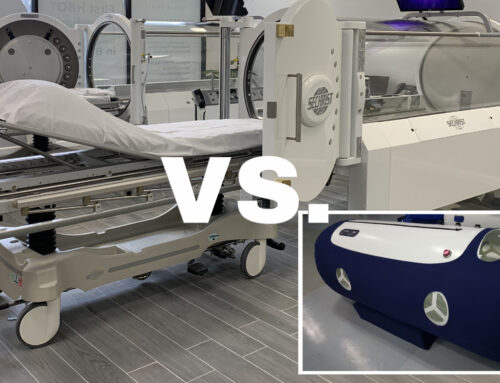Some studies suggest HBOT may help preserve or extend telomeres (protective DNA caps that shorten with age)
Telomeres, the protective DNA-protein structures at the ends of chromosomes, have emerged as one of the most fascinating areas of aging research. These molecular “caps” play a significant role in cellular health and longevity, gradually shortening with each cell division until they reach a critically short length that triggers cellular senescence or death. As scientists unravel the mysteries of aging, the potential to preserve or extend telomeres has become a holy grail in the quest for healthy longevity.
Understanding Telomeres and Their Role in Aging
Telomeres consist of repetitive DNA sequences (TTAGGG in humans) and specialized proteins that form a protective cap at chromosome ends. During each cell division, telomeres naturally shorten by approximately 50-200 base pairs, functioning as a cellular “molecular clock” that limits the number of times a cell can divide.
This process, known as the “end replication problem,” occurs because DNA polymerase cannot fully replicate the very ends of linear chromosomes. When telomeres become critically short, typically after 50-70 cell divisions, cells enter a state called senescence, where they stop dividing and may contribute to age-related dysfunction.
Alternatively, cells with severely shortened telomeres may undergo programmed cell death (apoptosis). This telomere shortening is associated with various age-related conditions, including cardiovascular disease, immune system decline, and increased cancer risk.
The enzyme telomerase can add telomeric DNA sequences to chromosome ends, effectively extending telomeres. However, in healthy adults, telomerase activity is primarily restricted to stem cells, germ cells, and highly proliferative tissues. Most somatic cells have minimal telomerase activity, making them susceptible to progressive telomere shortening over time.
Hyperbaric Oxygen Therapy: A Novel Approach
Hyperbaric oxygen therapy (HBOT) involves breathing pure oxygen in a pressurized chamber, typically at pressures 1.5 to 3 times greater than normal atmospheric pressure. Originally developed to treat decompression sickness in divers, HBOT has found applications in wound healing, radiation injury, and carbon monoxide poisoning.
Recently, researchers have begun investigating its potential anti-aging effects, particularly its impact on telomere biology. The theoretical basis for HBOT’s effect on telomeres centers on its ability to enhance oxygen delivery to tissues and potentially influence cellular metabolism and stress responses.
Hypoxia (low oxygen levels) accelerates telomere shortening and cellular senescence, while optimal oxygenation may support cellular repair mechanisms and telomerase activity.
Emerging Research on HBOT and Telomere Preservation
Preliminary studies have provided intriguing evidence that HBOT may influence telomere dynamics. The hyperoxic environment created during HBOT sessions appears to trigger several beneficial cellular responses that could theoretically support telomere maintenance. These responses include enhanced mitochondrial function, reduced oxidative stress (paradoxically, despite the high oxygen environment), and activation of cellular repair pathways.
One proposed mechanism involves the concept of “hypoxic-hyperoxic conditioning,” where alternating between normal atmospheric conditions and hyperoxic HBOT sessions may stimulate adaptive cellular responses. This conditioning effect might enhance the cell’s antioxidant defense systems and potentially influence telomerase activity, though the exact mechanisms remain under investigation.
Research has also suggested that HBOT may influence gene expression in telomere maintenance and cellular longevity pathways. The therapy modulates various signaling pathways, including those involved in cellular stress response and DNA repair, which could indirectly support telomere preservation.
Cellular Mechanisms and Potential Benefits
The potential benefits of HBOT for telomere health may occur through several interconnected mechanisms. Enhanced oxygen delivery to tissues could improve cellular energy production and support the energy-intensive processes involved in DNA repair and maintenance.
Additionally, HBOT may influence the cellular microenvironment by reducing factors contributing to accelerated telomere shortening. Oxidative stress, inflammation, and chronic disease states are all associated with accelerated telomere shortening.
HBOT’s documented anti-inflammatory effects and its ability to enhance the body’s natural antioxidant systems may create a more favorable environment for telomere preservation. The therapy’s impact on mitochondrial function is particularly relevant, as mitochondrial dysfunction and associated oxidative stress are significant contributors to cellular aging.
Furthermore, HBOT may influence stem cell function and mobilization. Since stem cells typically have higher telomerase activity than differentiated somatic cells, any therapy that supports stem cell health and function could potentially have positive effects on overall tissue maintenance and regeneration.
Current Limitations and Future Directions
While the preliminary research on HBOT and telomere biology is promising, significant limitations exist in our current understanding. Most studies to date have been small-scale or conducted in laboratory settings rather than large-scale human clinical trials.
The optimal protocols for HBOT in the context of telomere preservation – including pressure levels, session duration, frequency, and total treatment periods – remain to be established. Individual variations in response to HBOT is another important consideration.
Factors such as age, baseline health status, genetic variations in telomerase activity, and concurrent health conditions may all influence how effectively HBOT can impact telomere biology in different individuals.
The field also faces challenges in measuring telomere length accurately and consistently across different laboratories and methodologies. Standardized protocols for telomere assessment are critical for advancing research in this area and comparing results across studies.
Implications for Healthy Aging
If further research confirms HBOT’s ability to preserve or extend telomeres, the implications for healthy aging could be substantial. Telomere preservation might contribute to maintaining cellular function longer, potentially delaying the onset of age-related diseases and extending healthspan – the period of life spent in good health.
However, it’s important to note that telomere length is just one factor in the complex process of aging. A comprehensive approach to healthy aging must also address other factors such as lifestyle habits, nutrition, exercise, stress management, and social connections.
HBOT, if proven effective for telomere health, would likely be most beneficial as part of a broader healthy aging strategy rather than a standalone intervention. As research in this field continues to evolve, the potential for HBOT to contribute to telomere preservation represents an exciting frontier in aging research. This factor alone offers hope for interventions that could help people age more healthily and maintain vitality longer into their later years.
____________________________________________________________________________
1659 Ralph Ave., Brooklyn, NY 11236
phone 718-255-9955
fax 718-228-3772
___________________________________________________________________________
References
- Blackburn, E. H., Epel, E. S., & Lin, J. (2015). Human telomere biology: A contributory and interactive factor in aging, disease risks, and protection. Science, 350(6265), 1193-1198.
- Hachmo, Y., Hadanny, A., Mendelovic, S., Hillman, P., Shapira, E., Landau, G., Gattegno, H., Zrachya, A., Daniel-Kotovsky, M., Catalogna, M., Fishlev, G., Lang, E., Polak, N., Doenyas, K., Friedman, M., Zemel, Y., Bechor, Y., & Efrati, S. (2020). Hyperbaric oxygen therapy increases telomere length and decreases immunosenescence in isolated blood cells: a prospective trial. Aging, 12(22), 22445-22456.
- López-Otín, C., Blasco, M. A., Partridge, L., Serrano, M., & Kroemer, G. (2013). The hallmarks of aging. Cell, 153(6), 1194-1217.
- Thom, S. R. (2009). Oxidative stress is fundamental to hyperbaric oxygen therapy. Journal of Applied Physiology, 106(3), 988-995.






